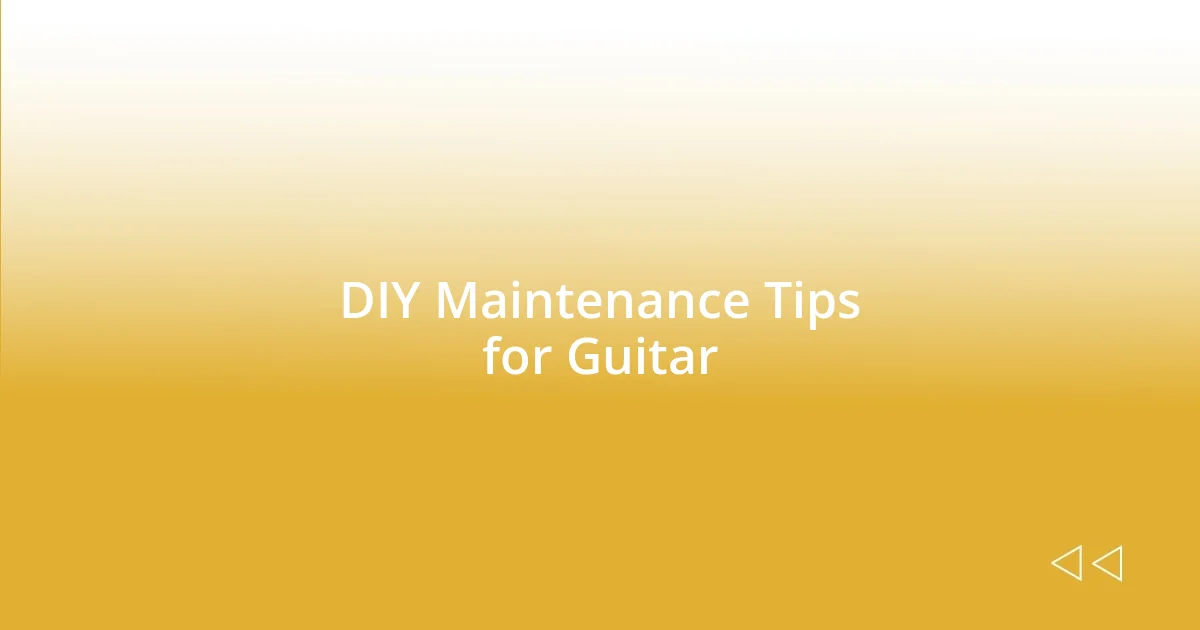Key takeaways:
- Regular guitar maintenance enhances sound quality and prevents costly repairs, promoting a better playing experience.
- Awareness of symptoms like sudden sound changes, string buzz, and playability issues can indicate underlying problems needing attention.
- Both DIY care and professional servicing have their benefits; a balance of self-maintenance and expert help can keep your guitar in optimal condition.

Importance of Regular Guitar Maintenance
Regular guitar maintenance is crucial for preserving the instrument’s sound quality and playability. I remember the first time I neglected to change my strings for months; it was like trying to sing with a sore throat. The moment I finally made the change, I was blown away by the rich tones I had been missing. Doesn’t it feel good to play an instrument that resonates beautifully?
Caring for your guitar is not just about aesthetics; it’s about enhancing your overall playing experience. I often think about how much joy my guitar has brought me over the years, and I can’t help but feel a pang of sadness when I see a neglected instrument. I once helped a friend tune his guitar, only to discover that years of dust accumulated in the soundhole impacted its sound. Isn’t it amazing how a little care can unlock its true potential?
Moreover, regular maintenance can prevent minor issues from spiraling into costly repairs. There was a time when I had to replace a guitar neck because I ignored a small crack that worsened over time. Learning from that experience taught me that a few minutes spent checking the setup can save both money and heartache down the road. Why risk losing a beloved instrument when a little attention can keep it in top shape?

Symptoms Indicating Guitar Problems
When I notice a sudden change in sound quality – perhaps it’s become overly muddy or unusually thin – it often sends up a red flag. Just last month, I had a similar experience with my favorite acoustic guitar. One moment, it was singing sweetly, and the next, it felt like I was strumming a piece of wood. Trust me, if your guitar starts to sound off, it’s a call to attention you shouldn’t ignore.
Another symptom I’ve learned to recognize is string buzz. If certain frets produce an unwanted rattling sound, it can be frustrating and quite telling. I remember playing at an open mic night and thinking, “Why is it buzzing like that?” Upon inspecting it later, I discovered that the neck had warped slightly due to humidity changes. Your guitar can communicate these issues; we just need to listen.
Finally, changes in playability, like strings feeling harder to press down, can indicate a setup problem or neck relief issue. I recall my fingers cramping mid-solo, only to find out that the action (the height of the strings from the fretboard) had become too high. Regular check-ups can catch these problems before they affect your performance, ensuring you continue to enjoy your instrument without unnecessary strain.
| Symptom | Possible Problem |
|---|---|
| Sudden change in sound quality | Worn or old strings, soundhole obstruction |
| String buzz when playing | Warped neck, high action |
| Difficulty pressing down strings | Neck relief issues, poor setup |

Frequency of Guitar Check-ups
As someone who plays guitar frequently, I’ve found that the frequency of check-ups can vary based on how often you play and the environment you keep your instrument in. For instance, during the summer months, I tend to do a quick check-up every couple of weeks because the humidity can affect the wood. When I used to practice daily, I made it a point to give my guitar a thorough inspection once a month. It didn’t take long before I realized that regularly tuning and adjusting settings was far more effective than waiting for problems to arise.
Here are some guidelines on how often to check your guitar, depending on your usage and environment:
- Daily Players: Check strings, tuning, and action every practice session.
- Weekly Players: Inspect for dust and adjust intonation and setup once a week.
- Occasional Players: A monthly check-up should suffice, focusing on strings and overall condition.
- Environmental Factors: If changes in temperature or humidity are significant, consider additional checks.
These practices have not only kept my guitar sounding its best but have also made me feel more connected to the instrument. I can’t stress enough how intimately knowing each notch, fret, and curve can elevate your playing experience. It’s like developing a friendship; the more care you put into it, the more depth there is to your connection.

What Happens During a Check-up
During a check-up, the technician will first assess the overall condition of the guitar, examining both the body and the neck. I remember one time, while getting my electric guitar checked, the guy noticed a slight dent on the body I hadn’t even seen. It was a small moment, but it reminded me how quickly wear and tear can sneak up on you.
Next, the strings will typically be evaluated and possibly replaced. I once found myself hesitating to change strings until my fingers were practically screaming for relief. When I finally did, it was like a rush of inspiration – the sound was so vibrant, and the playability improved immensely. Isn’t it funny how something as simple as fresh strings can reignite your passion for playing?
Finally, the technician usually checks the action and intonation setups, crucial for optimal playability. I once learned this the hard way when I thought my guitar just didn’t give me the same feel anymore. After a check-up, it turned out everything was just a bit off. It was a game-changer! How often do we overlook these adjustments that could elevate our playing experience? Regular check-ups are like a gentle nudge to ensure our beloved instruments stay in their best shape.

Essential Tools for Guitar Care
When it comes to essential tools for guitar care, I find a few items make all the difference. A good set of guitar strings is non-negotiable; I remember the first time I switched to a higher-quality string. The clarity and richness of sound blew me away! Alongside strings, a string winder and cutter is a lifesaver. Have you ever tried changing strings without one? It can become quite a tedious task, especially when you’re eager to play.
Another integral tool in my kit is a guitar tuner. I can’t stress enough how crucial it is to keep your instrument in tune. I’ve had moments where I thought I could “eyeball” it, only to realize later that a slight pitch difference had thrown me off during practice. A clip-on tuner makes it easy and quick. It’s like having an extra pair of ears just to ensure that everything is sounding as lovely as it should.
Lastly, don’t overlook the importance of a microfiber cloth. After a long session of playing, I find that wiping down the strings and body keeps everything fresh and free from oils and dirt. It’s such a small action, but it feels rewarding, like a little “thank you” to my guitar for all the music it creates with me. Every player has their preferred tools, but these essentials have certainly enhanced my guitar care routine and helped maintain the love I have for my instrument. What are your must-haves?

DIY Maintenance Tips for Guitar
It’s amazing how a simple routine can extend the life of my guitar. I like to give each fretboard a good cleaning with lemon oil, especially after a few intense jam sessions. The first time I did this, I could hardly believe how much grime had built up. It felt like I was uncovering the guitar’s true beauty underneath all that dust. Have you ever noticed how a clean fretboard can transform both the look and feel of your instrument?
Another tip I swear by is regularly checking the neck relief. I remember my old acoustic guitar getting so tense that playing became a chore. One day, I decided to measure the relief myself using a capo and a feeler gauge. Adjusting the truss rod was intimidating at first, but seeing the action lighten up afterward felt like a small victory. Do you ever feel that rewarding rush when you troubleshoot something on your own?
Lastly, I recommend keeping a close eye on the tuners and hardware. There was a time when my tuning pegs became loose, which created this frustrating slipping issue during performances. I took matters into my own hands, tightened everything up, and the difference was night and day. It’s almost addictive to know that with a bit of attention and care, I can keep my guitar sounding perfect. What small adjustments have you made that made a huge difference?

Professional Service vs DIY Care
When considering professional service versus DIY care for my guitar, I often weigh the pros and cons. A professional setup can provide a level of precision that I sometimes can’t achieve on my own. I remember the first time I took my guitar to a luthier for a setup; they adjusted the action and intonation perfectly. It felt like playing a different instrument—so smooth and responsive! Have you experienced that exhilarating moment of transformation when you hand your guitar over to someone who truly knows its anatomy?
On the flip side, there’s a satisfying joy in taking care of my instrument myself. It’s like a personal bond; every adjustment I make feels like I’m nurturing a living thing. I recall a time when I replaced the nut on my guitar. It was nerve-wracking, but when I played the first chord and heard that clear sound, I felt an immense sense of pride. Isn’t it amazing how a single decision to try something new can deepen our appreciation for our instruments?
Ultimately, I believe both routes have their merits. When I encounter a challenging issue, I usually exhaust my DIY options first, but I’m not afraid to seek professional help when needed. After all, nothing compares to the expertise a seasoned technician brings, especially for more complex problems. What balance do you strike between DIY care and calling in the pros for your guitar?















